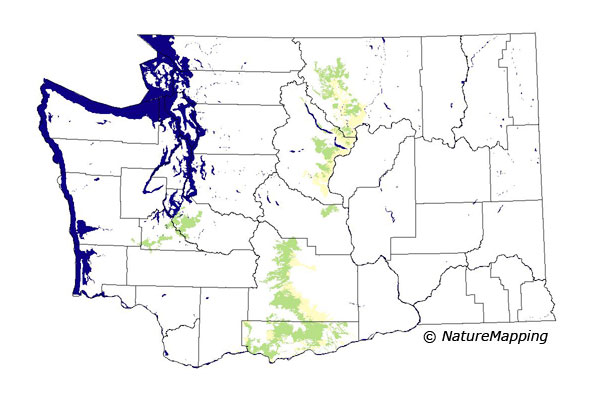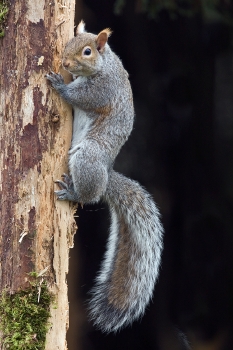


Western Gray Squirrel (Sciurus griseus) What they look like: Western gray squirrels are the largest native tree squirrels in Washington. They are salt-and-pepper to steel gray on the back with contrasting white underparts. These squirrels are distinguished by their very long and bushy white-edged tails, large feet and prominent ears, which are reddish-brown at the back in winter. The long tail is used for balance when dashing between tree branches. Length: Up to 24 inches long (Body: 12" Tail: 12"). 
Weight: Weigh between 12oz to 33oz pounds (350 to 950 g). Where they live: They can be found in Washington, Oregon, California, and in a small part of Nevada. Western grey squirrels are found in oak woodlands and coniferous forests. They can be found at elevations up to 2,500 meters. This species is listed as threatened in Washington State. The Eastern gray squirrel is an introduced species and may be a primary reason why the Western gray squirrels are declining. Nesting: Western grey squirrels live in hollow trees or in nests they build called dreys. It makes a nest of twigs in the branches of trees and lines it with grass or moss. Signs: Chewed cones and needle clusters on the ground may be a sign of western gray squirrel feeding activity. Large piles of cone scales generally indicate Douglas' or red squirrels. What they eat: Nuts, acorns, and seeds they steal that people put out to feed the birds. Extra food is collected and taken back to the nest or buried around their home range. The buried food is called a cache and can be found months later by their good sense of smell. Caches are usually used in the colder months when food is scarce. Behavior: Western grey squirrels make loud barking sounds, flick their tails and stamp their feet when threatened. Reproduction: They mate in the late winter months. Litter Size: Their first litter has 3 to 5 young that are born in the spring. Their second litter is born in late summer. Gestation periods last about 43 days. Young are born without hair and with closed eyes and ears. They are weaned at approximately 10 weeks. Did you know?
Animal silhouettes available to purchase » Photos: Natures Pics
Western Gray Squirrels - Washington Department of Fish and Wildlife Home | About Us | How to Participate | Biodiversity Modules | Projects | Maps | News | Resources |